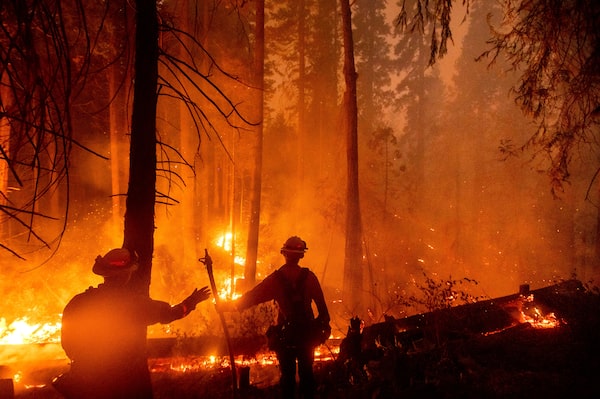
Firefighters Nick Grinstead and Trevor While battle the Creek Fire in the Shaver Lake community of Fresno County, Calif., on Monday, Sept. 7, 2020.Noah Berger/The Associated Press
Helicopters rescued more people from wildfires Tuesday as flames chewed through bone-dry California after a scorching Labor Day weekend that saw a dramatic airlift of more than 200 people and ended with the state’s largest utility turning off power to 172,000 customers to try to prevent more blazes.
Three early morning helicopter flights pulled another 35 people from the Sierra National Forest, the California National Guard said.
California has already set a record with 2 million acres (809,000 hectares) burned this year, and the worst part of the wildfire season is just beginning. The previous record was set just two years ago and included the deadliest wildfire in state history, which swept through the community of Paradise and killed 85 people.
That blaze was started by power lines amid strong winds and tinder-dry conditions. Liability from billions of dollars in claims from that and other fires forced the Pacific Gas & Electric utility to seek bankruptcy protection. To guard against new disasters, the company last year began pre-emptive power shut-offs when fire conditions are exceptionally dangerous.
That’s the situation now in Northern California, where high and dry winds are expected until Wednesday. PG&E said it has learned from past problems and will seek this year to make the outages “smaller in size, shorter in length and smarter for customers.”
More than 14,000 firefighters are battling more than two dozen fires around the state. Two of the three largest blazes in state history are burning in the San Francisco Bay Area.
California was not alone: Hurricane-force winds and high temperatures kicked up wildfires across parts of the Pacific Northwest over the holiday weekend, burning hundreds of thousands of acres and mostly destroying the small town of Malden in eastern Washington.
In Southern California, fires were burning in Los Angeles, San Bernardino and San Diego counties. The U.S. Forest Service on Monday decided to close all eight national forests in the region and to shutter campgrounds statewide.
“Existing fires are displaying extreme fire behaviour. New fire starts are likely. Weather conditions are worsening, and we simply do not have enough resources to fully fight and contain every fire,” said Randy Moore, a forester for the Forest Service’s Pacific Southwest region that covers California.
Lynne Tolmachoff, spokeswoman for the California Department of Forestry and Fire Protection, known as Cal Fire, said it’s “unnerving” to have reached a record for acreage burned so soon. September and October usually are the worst months for fires because vegetation has dried out and high winds are more common.
While the two mammoth San Francisco Bay Area fires were largely contained after burning for three weeks, firefighters struggled to corral several other major blazes ahead of the expected winds. Evacuation orders were expanded to more mountain communities Monday as the so-called Creek Fire chewed through the Sierra National Forest in Central California.
It was one of many recent major fires that displayed terrifyingly swift movement. The fire advanced 15 miles (24 kilometres) in a single day during the weekend. Since starting Friday from an unknown cause, it has burned 212 square miles (549 square kilometres). Forty-five homes and 20 other structures were confirmed destroyed so far.
Debra Rios wasn’t home Monday when the order came to evacuate her hometown of Auberry, just northeast of Fresno. Sheriff’s deputies went to her ranch property to pick up her 92-year-old mother, Shirley MacLean. They reunited at an evacuation centre.
“I hope like heck the fire doesn’t reach my little ranch,” Rios said. “It’s not looking good right now. It’s an awfully big fire.”
Mountain roads saw a steady stream of cars and trucks leaving the community of about 2,300 on Monday afternoon.
Firefighters working in steep terrain saved the tiny town of Shaver Lake from flames that roared down hillsides toward a marina. About 30 houses were destroyed in the remote hamlet of Big Creek, resident Toby Wait said.
“About half the private homes in town burned down,” he said. “Words cannot even begin to describe the devastation of this community.”
A school, church, library, historic general store and a major hydroelectric plant were spared in the community of about 200 residents, Wait told the Fresno Bee.
Sheriff’s deputies went door to door to make sure residents complied with evacuation orders. Officials hoped to keep the fire from pushing west toward Yosemite National Park.
Early Tuesday, California National Guard and Navy helicopters rescued 13 people from the China Peak area and 22 from Lake Edison and flew them to Fresno Air Terminal, the Guard said. The rescue flights were thwarted earlier by heavy smoke Monday night.
On Saturday, National Guard rescuers in two military helicopters airlifted 214 people to safety after flames trapped them in a wooded camping area near Mammoth Pool Reservoir. Twelve people were hospitalized, two of them with seriously injuries.
One of the Southern California fires closed mountain roads in Angeles National Forest and forced the evacuation of the historic Mount Wilson Observatory. Late Monday night, the Los Angeles County Fire Department told residents of Duarte, Bradbury and Monrovia near the forest to get ready for a possible evacuation.
Cal Fire said the so-called El Dorado Fire in San Bernardino County started Saturday morning when a smoke-generating pyrotechnic device was used by a couple to reveal their baby’s gender.
Our Morning Update and Evening Update newsletters are written by Globe editors, giving you a concise summary of the day’s most important headlines. Sign up today.